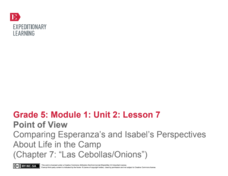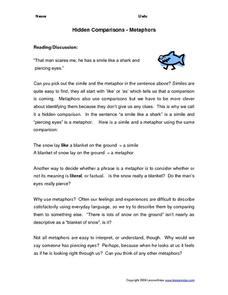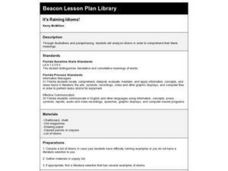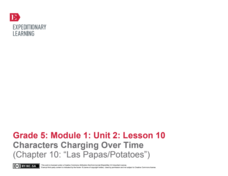Curated OER
Visual Puns - Paper Mache Sculpture
Explore the pop art movement and create a sculpture in the pop art style based on a visual pun, or play on words. The scholar's work may use humor, allegory, metaphor, or be in the form of a parody. Visual examples are provided, and some...
Curated OER
Idiom Dictionary
Clear up some common idioms for your English learners (or any other class) with this presentation. Expressions such as "Go fly a kite" and "He kicked the bucket" are coupled with pictures, some of which are unclear and could be confusing...
Curated OER
Figurative Language
Students put poetic interpretations back together to explain the poem. Starting with cliches, students learn what various phrases mean. They analyze words, phrases and levels of meaning.
Curated OER
The Old Man and the Sea: Guided Imagery
What do you imagine when you think of the sea? Put on some ocean sounds, close your eyes, and listen to a guided meditation based on the imagery from The Old Man and the Sea by Ernest Hemingway. After class members listen to the...
EngageNY
Point of View: Comparing Esperanza's and Isabel's Perspectives About Life in the Camp (Chapter 7: "Las Cebollas/Onions")
Explore point of view and more with a Common Core-designed instructional activity. Learners experience different points of view by representing one of two characters from Esperanza Rising during a partner discussion. They must use...
Curated OER
Blanket the Plains
Students discuss vivid imagery in a story. In this figurative language lesson, students read samples of sensory language and then discuss the meaning of a piece of figurative language. Students provide examples.
Curated OER
Hidden Comparisons - Metaphors
In this metaphors worksheet, students review, identify, and explain meanings of metaphors in sentences. In this drawing and short answer worksheet, students answer eleven questions.
Prestwick House
Introducing Symbols–The Beach
Looking for a way to introduce class members to the concept of symbolism and multiple levels of meaning? Readers examine two different passages about the beach and consider how the writers use concrete objects, and places to represent...
Curated OER
Allegory in Painting
High schoolers examine how allegory is defined and used in the visual arts. They create a list of the arts, and list the objects, symbols, and figures that suggest each art category, analyze various paintings, and identify the...
EngageNY
Mid-Unit Assessment and Discussing Themes in Esperanza Rising: (Chapter 9: "Las Ciruelas/PLums")
Give this skills-based assessment halfway through your unit on Esperanza Rising. After a brief review, class members take the test, which asks them to show that they know how to analyze the novel independently. They are asked to...
Curated OER
"How to Eat a Poem"
Eighth graders write a poem showing what they know about metaphors, and non-literal language to express ideas, convey meaning, and create images after they read Eve Merriam's "How to Eat a Poem".
Curated OER
Idiom Games
Learners identify idioms as groups of words with special meanings that paint a mental picture for the reader.They compete in a game in which they draw and interpret pictures of idioms.
Curated OER
It's Raining Idioms!
Sixth graders analyze idioms and find examples from literature. They choose one idiom and finds pictures or draws pictures to show what it would mean if taken literally and what is it generally thought to mean.
Curated OER
Idioms and Slang
In this idioms and slang worksheet, students answer questions about where they hear idioms and slang terms where they live. Students answer 15 questions, and fill in a chart for what the slang terms mean.
Curated OER
Idioms
In this idiom activity, students study 23 English idioms. Students match each given idiom with its literal definition and meaning.
Curated OER
The Outsiders
Tenth graders complete a variety of activities related to the first two chapters of the book The Outsiders. They define metaphor, simile, idiom, and hyperbole, and take a vocabulary pre-quiz. In small groups, they write a character...
EngageNY
Grade 9 ELA Module 2, Unit 2, Lesson 20
Oedipus' lack of literal and figurative vision does not mean he cannot see his guilt in the terrible fates of Laius, Jocasta, and all the lives touched by prophecy. Conclude a literary analysis unit on Sophocles' Oedipus the King with a...
Shmoop
ELA.CCSS.ELA-Literacy.RL.11-12.4
Your assessment is to figure out if I am being figurative or connotative with this statement: This is a great resource. Can’t do it? Then you had better review how to break down Common Core skill RL.11-12.4. In simple language that you...
Shmoop
ELA.CCSS.ELA-Literacy.RL.11-12.6
It ‘s assessment check list time, and you have nothing to prove that your learners mastered the skill RL.11-12.6. Rest assured, here is a plan that is sure to appease your administrator. It offers solid examples on the difference between...
Curated OER
Say It with Meaning: Applying Sayings and Phrases
Students complete a unit of lessons on well known sayings and phrases. They create a journal, write paragraphs, sequence events, and analyze key vocabulary for various sayings and phrases throughout the school year.
Curated OER
Idioms
In this idiom instructional activity, 4th graders master the meanings of five idioms. Students complete 5 fill in the blank statements and 8 multiple choice questions using the given idioms and their literal meanings.
Achieve3000
Context Clues and Idioms
Kids practice using five types of context clues (definition, synonym, antonym, example, and general) to decode idiomatic language.
EngageNY
Characters Changing Over Time (Chapter 10: "Las Papas/Potatos")
Engage further in Esperanza Rising with a focus on close reading and metaphor. Class members zero in on the tenth chapter, examining characters and big ideas. Pupils discuss the text in small groups and as a whole class, and participate...
EngageNY
Revisiting Big Metaphors and Themes: Revising and Beginning to Perform Two-Voice Poems
Now that your class has read all of Esperanza Rising, take the time to tackle big metaphors and themes. Pupils will participate in an activity called Chalk Talk, in which they circulate around the room in small groups and add comments to...

























